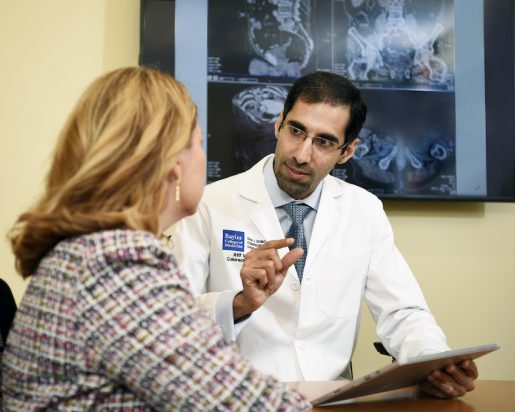Understanding Hemorrhoids and Your Treatment Options
Some health issues are hard to talk about, even with your healthcare provider, but it’s important that you do. One such condition is hemorrhoids.
 Hemorrhoids have been called “vascular cushions” that surround the anus. There are two types:
Hemorrhoids have been called “vascular cushions” that surround the anus. There are two types:
- Internal hemorrhoids, covered by mucosa, inside the anus
- External hemorrhoids, covered by skin, outside the anus
They are normal parts of your body, but the condition that people refer to as “hemorrhoids” develops when these cushions cause problems, such as bleeding or protruding. There is a lot of pressure placed on these cushions every time you have a bowel movement, and this pressure can inflame or engorge the hemorrhoids with blood, especially the internal ones. There are three sets of these cushions—two on the right and one on the left. When engorged or swollen they bulge out like varicose veins on the legs, and they can bleed bright blood that you might see on your toilet paper, covering your stool or mixed in with the toilet water (Grade I hemorrhoids).
These cushions also are expandable, like balloons, that get larger as you’re pushing stool out. They sometimes pop right outside the anus. However, because they’re attached inside the body, when you stop pushing, they get sucked back in; doctors call this “spontaneously reducing” (Grade II hemorrhoids). Over time, those cushions can stay outside the body even after you stop pushing. When that happens, you can make them go back inside by using your gloved fingers to push them back inside the anus; doctors call this “manually reducing” and is done by your healthcare provider during an in-clinic exam. (Grade III hemorrhoids).
With advanced disease, pushing them inside doesn’t help; even if you try, they just come right back out (Grade IV hemorrhoids). Internal hemorrhoids that bleed or protrude or both usually don’t cause sharp or burning pain that some people have around the anus. That kind of pain is usually caused by an anal fissure (tear in the anal skin).
External hemorrhoids cause problems when a small blood clot forms in them. It feels like a knot or little ball right outside the anus. These can hurt worse than internal hemorrhoids because the nerve endings in the skin covering these hemorrhoids perceive this as sharp or burning pain. If you wait three or four days after one of these clots form, they begin to dissolve, and the pain fades away with the clot. Sometimes the clot stretches the overlying anal skin and a skin tag develops. People often think these skin tags are hemorrhoids but they’re not and don’t need treatment.
Hemorrhoid Prevention and Treatment
Non-surgical: Try to prevent Grade I from developing to Grade IV internal hemorrhoids. Increase fiber in your diet and drink more water. Avoid foods that often cause constipation, such as white rice, white bread and other processed grains, red meat, alcoholic beverages and bananas. This will help your stool move through your digestive system with less straining. Avoid pushing or straining excessively during bowel movements. If you’re sitting on the toilet for too long without having a bowel movement, get up and try again later. Distract yourself with some other activity for a while. It’ll happen when it happens!
When hemorrhoids bleed, your doctor can prescribe Anusol HC (hydrocortisone) suppositories that you insert into the anus to reduce the swelling and/or bleeding. Use care and don’t rush when using this medication.
For external hemorrhoids, sit in a bathtub of hot water for 10-15 minutes and take over-the-counter ibuprofen. Avoid going to the emergency room if you can. Remember, most clots that cause pain with external hemorrhoids start to dissolve in 72 hours.
Surgical: A colorectal surgeon may treat any hemorrhoid grade with various procedures; however, these are often reserved for Grades II-IV. Surgeons can treat Grade I-II hemorrhoids in the outpatient setting by injecting a sclerosing agent, which is a chemical that hardens the inside of the small vessels within the hemorrhoid, so it doesn’t swell up with blood or other fluid. They can do a similar process with an instrument that uses infrared energy. They can also perform a band ligation, where a special instrument is used to deploy a small rubber band around the base of the internal hemorrhoid and in a few days that part of the tissue dies and sloughs off and out. With Grades III and IV internal hemorrhoids, surgeons usually perform an operating room procedure to remove the hemorrhoids while the patient is under anesthesia.
If you are experiencing symptoms of hemorrhoids such as rectal bleeding or blood in your stool, always consult with a physician as bleeding can be a sign of other serious conditions. Seek the advice of a physician before trying any treatment options.
Visit the Healthcare page to learn more about our colorectal surgery team.
-By Brian Lassinger, instructor of surgery and physician assistant in the Michael E. DeBakey Department of Surgery at Baylor College of Medicine



